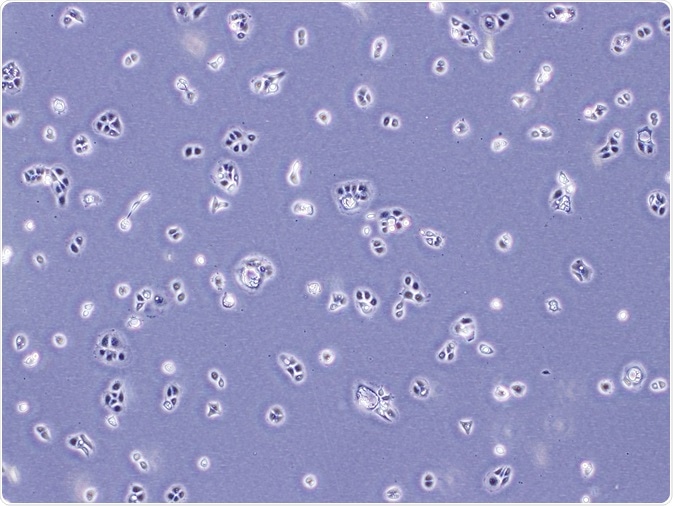Which Of The Following Accurately Describes The Relationship Between Melanocytes And Skin Cancer?
Basal Cells, Keratinocytes and Melanocytes
By Jeyashree Sundaram, MBA
The human skin, which is fabricated up of multiple cells, is one of the nigh complex organs in the human body. The diverse pare cells complement each other by working in coordination and performing effective functions like skin homeostasis; the peel also acts as a barrier for protecting the internal organs from harmful ultraviolet radiation.
 Credit: Chedped Studio/ Shutterstock.com
Credit: Chedped Studio/ Shutterstock.com
Each skin jail cell has functional roles that are carried out in their particular region of existence. The basal jail cell layer is the innermost layer of the epidermis, comprising the keratinocytes and melanocytes. Keratinocytes play an important function in providing skin structure and in performance of the immune system. Melanin is a pigment produced by melanocytes, and is responsible for providing the peel color.
Basal cells
Basal cells are small-scale round-shaped cells found in the basal cell layer. Pare cells are first produced in this region past continuous division, giving rise to new skin cells. These new cells continuously force the older cells toward the uppermost layer of the skin, where they are finally shed. The basal layer is otherwise called the stratum germinativum, equally the cells produce new cells continuously.
These cells are composed of basophilic cytoplasm and a chromatin-rich nucleus in an elliptical shape. Basal cells contain gap junctions for prison cell advice, desmosomes for jail cell-to-cell zipper, hemidesmosomes for connecting with the basal membrane, and an extracellular matrix.
Keratinocytes
Keratinocytes are found in the outermost layer of the skin, chosen the epidermis. The epidermis is equanimous of 95% keratinocyte cells. The cells in the basal layer are sometimes chosen basal keratinocytes or basal cells. The epidermis is near 0.2 mm thick. Inside the epidermis, keratinocytes are bundled in iv dissimilar layers — the stratum basale, stratum spinosum, stratum granulosum, and stratum corneum.
The stratum basale is the basal layer of the epidermis that covers the keratinocyte stalk cells and differentiating keratinocytes. Prison cell proliferation and partitioning take place in this layer.
The stratum spinosum comprises of keratinocytes with 8 to 10 sheets that have a reduced potential for jail cell division.
The stratum granulosum is the inner surface made upwardly of a granular layer with iii to 5 sheets of keratinocytesthat cannot be divided.
The stratum corneum is the cornified layer of the peel consisting of fifteen–30 sheets of corneocytes.
The cardinal function of keratinocytes is to develop a barricade confronting environmental changes such as UV radiation, heat, pathogens (fungi, viruses, bacteria, parasites), and water loss and likewise play a significant role in signal transduction inside the extracellular matrix.
Stem cells of keratinocytes are plant in the epidermal basal layer, which is the innermost layer of stratified epithelia. Separation of these cells leads to transient amplifying cells which additionally divide and distinguish as they motility toward the epidermal layer.
Keratins are the major proteins identified in keratinocytes. These proteins help in the germination of keratinocytes cytoskeleton, and keratin expression modifies as transient amplifying cells that differentiate and move upwardly to the stratum corneum, developing equally hair and nails. Any defect in keratin expression will issue in epidermal diseases that also occur in the nails and hair.
Role of keratinocytes in immune organisation
Keratinocytes function as immunomodulators and produce inhibitory cytokines when there is no cut or injury, triggering inflammation; finally, in response to injury, the Langerhans cells are activated past keratinocytes. When the pare is infected, Langerhans cells perform like antigen-presenting cells, which are the first cells to human action upon microbial antigens that enter into the body from ruptured pare.
Melanocytes
Melanocytes are identified at the epidermal–dermal junction of the basement membrane. Melanin pigments which are synthesized provide unlike pare colors and also protect the skin from ultraviolet radiation. Sunlight exposure makes melanocytes to increase product of melanin, and thereby darken the peel for protection.
Thus, the skin gets a suntan. After synthetization of melanin, they are stored within the melanosomes and and so transferred to the peak layer of suprabasal keratinocytes with the assistance of extended dendrites. Melanin functions as a natural sunscreen for the torso.
Melanins are classified as:
- Eumelanin—that gives the blackness or brown color to skin and hair of humans;
- Pheomelanin—that gives yellow to reddish chocolate-brown color, majorly establish in the female person skin;
- Neuromelanin—that produces brown or blackness color in a specific region of the brain;
- and both pheomelanin and eumelanin.
The man skin has about 1000—2000 melanocytes per foursquare millimeter. The basal cell layer consists of most 5%–x% of melanocytes cells. Although every person possesses a unique skin colour, the melanocyte density is similar in all types of skin. The of import components of the basement membrane are collagen 7, collagen blazon IV, and the laminins.
Being of the basement membrane is required for alignment of melanocytes, whereas in the result of nonexistence of the basement membrane, the melanocytes cells are moved to the uppermost layer of the keratinocytes and suffer spontaneous pigmentation.
Further Reading
- All Dermatology Content
- What is Dermatology?
- Dermatologic Therapy
- Dermatologist Education and Training
- Curettage (Dermatology)
Terminal Updated: May 23, 2019
Suggested Reading








Which Of The Following Accurately Describes The Relationship Between Melanocytes And Skin Cancer?,
Source: https://www.news-medical.net/health/Basal-Cells-Keratinocytes-and-Melanocytes.aspx
Posted by: scotthings1958.blogspot.com


0 Response to "Which Of The Following Accurately Describes The Relationship Between Melanocytes And Skin Cancer?"
Post a Comment